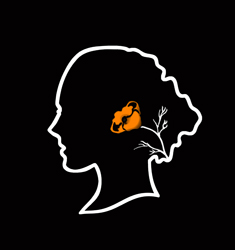Luis Carlos Garcia, UCSB Student Intern, "Writing About Art",Economics Major, from Tijuana, Mexico
Madonna del Prato by Giovanni Bellini
by Luis Carlos Garcia
Holli Harmon’s portrait of Ernestine De Soto captures her personal identity and ties it with that of her ancestors. Inspired by the idea of the first contact between Europeans and the peoples of the Americas around the 15th and 16th century, Harmon uses a technique that the European artists used at the time called egg tempera. This is a slow process to paint with since it applies layers and layers of egg yolk and pigments. The style of the piece also takes inspiration from a famous Italian painting titled Madonna del Prato by Giovanni Bellini. In Bellini's painting the central figures and the background are connected.
Ernestine De Soto, egg tempera, 12x16 by Holli Harmon
Beginning with the surroundings, Harmon’s portrait illustrates the scenery of Santa Barbara as it was when the friars founded Mission. Sycamores, aloe vera, and agave century plant, all native plants of California, covered the arid lands. Replacing the castle in Bellini’s original painting, the Mission stands as the symbol of the Spanish encounter with the Chumash and how it has played a large part in the California Native American’s history as well as De Soto’s personal life. The Mission stands almost alone, surrounded by wild vegetation but illuminated from the inside, showing signs of life. There are two figures, both related to the Mission, at both sides of De Soto. On the right, a Franciscan friar, distinguished by his brown habit, watches over the cows and the Chumash laborer on the left. As part of De Soto's nursing career she cared for the aging and infirm priests who retired to the Santa Barbara mission. De Soto befriended many of these aging priests and says that she loved them a lot and has many humorous stories to tell about those years of nursing.
At the center stands De Soto herself. Her thick black hair follows the traditional braided style of the Chumash. Among her jewelry, she wears bracelets made of various shells and her earrings of white abalone, materials very often used by her ancestors. Around and down her neck hangs a cross, representing her devoutness to the Catholic faith. She wears a customary white dress and in her hands is the Tule reed, the plant used in Chumash basket weaving, which is their famous art and craft. As her scepter, it points to the night sky where several white stars form the Ursa Major and Ursa Minor constellations. Translated as Big Bear and Little Bear, the constellations’ names recall a Chumash parable, The Sugar Bear. De Soto’s mother used to tell her this story at bedtime. The bear constellations hang as a symbol of De Soto’s love and admiration for her mother.
To learn more about Ernestine De Soto, visit her story here.




